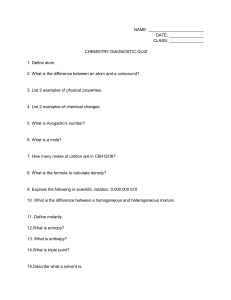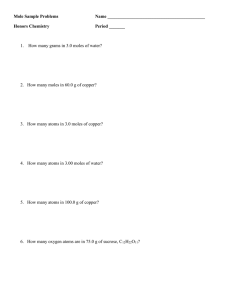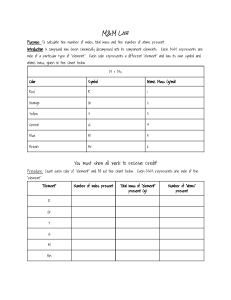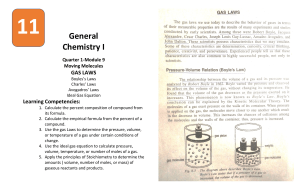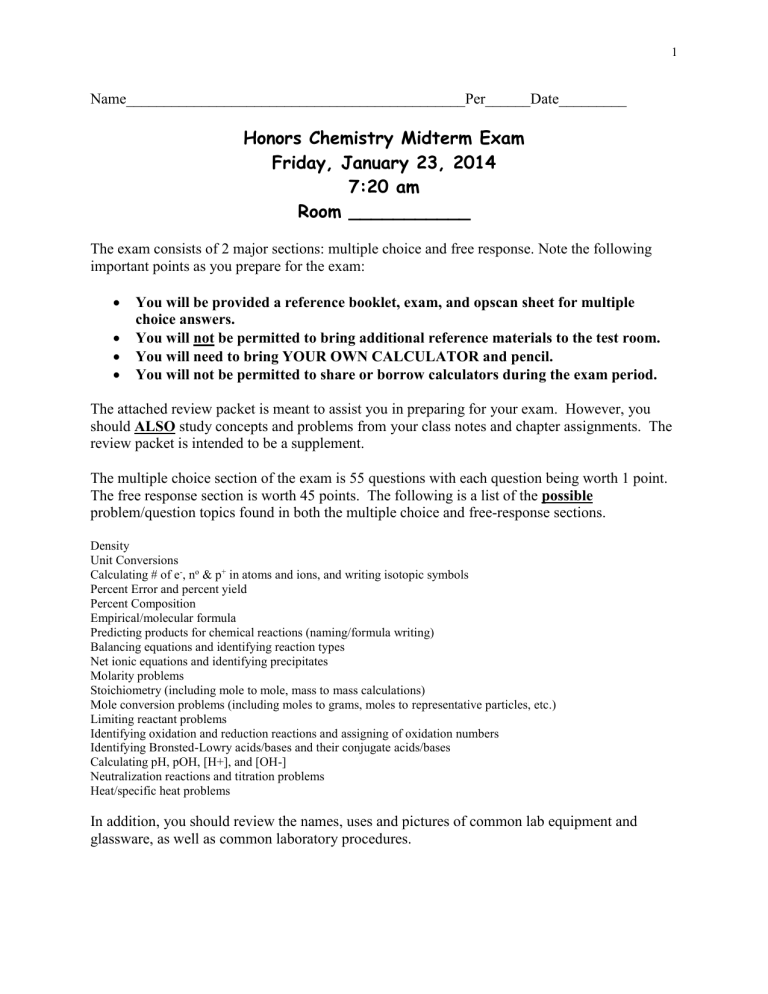
1 Name_____________________________________________Per______Date_________ Honors Chemistry Midterm Exam Friday, January 23, 2014 7:20 am Room ___________ The exam consists of 2 major sections: multiple choice and free response. Note the following important points as you prepare for the exam: You will be provided a reference booklet, exam, and opscan sheet for multiple choice answers. You will not be permitted to bring additional reference materials to the test room. You will need to bring YOUR OWN CALCULATOR and pencil. You will not be permitted to share or borrow calculators during the exam period. The attached review packet is meant to assist you in preparing for your exam. However, you should ALSO study concepts and problems from your class notes and chapter assignments. The review packet is intended to be a supplement. The multiple choice section of the exam is 55 questions with each question being worth 1 point. The free response section is worth 45 points. The following is a list of the possible problem/question topics found in both the multiple choice and free-response sections. Density Unit Conversions Calculating # of e-, no & p+ in atoms and ions, and writing isotopic symbols Percent Error and percent yield Percent Composition Empirical/molecular formula Predicting products for chemical reactions (naming/formula writing) Balancing equations and identifying reaction types Net ionic equations and identifying precipitates Molarity problems Stoichiometry (including mole to mole, mass to mass calculations) Mole conversion problems (including moles to grams, moles to representative particles, etc.) Limiting reactant problems Identifying oxidation and reduction reactions and assigning of oxidation numbers Identifying Bronsted-Lowry acids/bases and their conjugate acids/bases Calculating pH, pOH, [H+], and [OH-] Neutralization reactions and titration problems Heat/specific heat problems In addition, you should review the names, uses and pictures of common lab equipment and glassware, as well as common laboratory procedures. 2 1. Introduction A. Identify each of the following as either a physical or chemical change. 1. 2. 3. 4. Wax melting. Iron rusting. Hydrogen and oxygen combining together to form water. Distillation (separation by boiling) of water. B. Identify each of the following as either a physical or chemical property. 1. 2. 3. 4. 5. Color Reactivity with oxygen Solubility in water Density If the substance is an acid or a base C. Identify each of the following as either an extensive or intensive property. 1. 2. 3. 4. Volume Boiling Point Mass Density D. Distinguish between precision and accuracy. E. How is percent error calculated? 2. Conversions and Density A. A solid object with a mass of 22.50 g and a density of 4.50 g/mL is placed in a graduated cylinder with 30.6 mL of water in it. When the object is completely submerged in the water, what will the new volume reading in the cylinder be? 3 B. How many mm are there in 2.95 x 106 km? C. How many cubic cm are there in 10.8 cubic decameters? D. The density of potassium dichromate is 2.68 g/cm3. Express this number in pounds per cubic foot. ( 1.00 lb = 454.0 g and 1.00 in = 2.54 cm) 3. Chemical laws A. Law of conservation of mass B. Law of multiple proportions C. Law of constant composition (definite composition) A. For each of the following statements, consider which law above best applies to it. Then, write the letter of the law next to its number. 1. All water is exactly 11.11% hydrogen by mass. 2. In the reaction between hydrogen and oxygen, exactly 2.02 g of H2 react with exactly 32.00 g of O2 to form 34.02 g of H2O. 3. In one compound, 6.00 g of carbon combines with 8.00 g of oxygen. In a second compound, 6.00 g of carbon combines with 16.00 g of oxygen. B. Explain the difference between a law and a theory. 4 4. Atomic Structure A. In one atom of uranium-235, there are _________protons, ___________neutrons and ____________electrons. B. Given an ion of sulfur-34: 1. Write the symbol: 2. List the number of protons_______, neutrons________ and electrons. C. List the contributions (experiments and conclusions) of each of the following scientists who helped develop current atomic theory. 1. J.J. Thomson 2. Millikan 3. Rutherford 4. Bohr 5. Lavoisier 6. Mendeleev D. Define isotope. 5 E. Explain how the atomic masses on the periodic table are calculated from the naturally occurring isotopes. 5. Formulas/Naming, Mole Conversions and Molarity A. Write the formula for each of the following, and classify each as ionic or covalent. 1. aluminum sulfate 2. sulfur trioxide 3. copper (II) hydroxide 4. iron (III) phosphate B. Define the mole. C. Distinguish between a strong, weak and non-electrolyte. D. Calculate the following quantities. 1. How many nitrate ions in 2.50 moles of aluminum nitrate? 2. How many moles of CO2 are there in a 450. g sample of CO2? 3. What is the mass of 8.00 x 1024 formula units of NaCl? 6 4. How many grams of aluminum nitrate are needed to make 350. mL of a 1.45 M solution? 5. If 2.00 g of sodium sulfate are dissolved in 20.0 mL of solution, what is a. the molarity of the solution? b. the molarity of the sodium ions? 6. What is the percent by mass of hydrogen in ammonium phosphate? 7. When oxygen is bubbled through a solution of sodium polysulfide, a compound used in photography called “hypo” is produced. What is the empirical formula of hypo if it consists of 29.08% sodium, 40.57% sulfur, and the remainder is oxygen? 8. The empirical formula of a compound is C2H3. What is the molecular formula of this compound if the molar mass is 135 g/mole? 7 6. Stoichiometry 1. Given the following UNBALANCED equation: C3H8 (g) + O2 (g) CO2 (g) + H2O (l) a. If you react 2.00 g of C3H8 with 8.00 g of O2, what mass of water (the theoretical yield) is formed? b. If 2.25 g of water is produced experimentally, what is the % yield? 2. Nitrogen gas is reacted with hydrogen gas to produce ammonia, NH3. (Ammonia is used to make fertilizers for lawns and gardens) a. Write a balanced equation with the smallest whole-number coefficients for the reaction of nitrogen gas with hydrogen gas to produce ammonia. b. How many moles of ammonia are formed when 1.34 moles of nitrogen react? c. How many grams of hydrogen are required to produce 2.75x103 g of ammonia? 8 7. Equations and Aqueous Solutions A. First, write a balanced chemical equation for each reaction. Next, classify each reaction(synthesis, decomposition, single replacement, double replacement). 1. nitrogen gas and magnesium metal react to form solid magnesium nitride. Balanced chemical equation: Type: ___________________ 2. Aqueous silver nitrate and nickel metal react to form silver metal + aqueous nickel (III) nitrate. Type:____________________________ 3. Solid Platinum (IV) fluoride reacts to form platinum metal and fluorine gas Type: ___________________ 4. When a solution of sodium sulfate is added to a solution of iron (III) nitrate, a precipitate forms. a. Write the complete balanced equation for the reaction. b. Identify the precipitate: ________________________ c. Identify the type of reaction: ___________________ d. Identify the spectator ion(s):_____________________ e. Write the net ionic equation: 9 8. Acids and Bases 1. Complete the following Brønsted-Lowry equations to demonstrate the acidity of HCN and the basicity of NH3. Identify the conjugate acid and base in each equation. HCN + H2O ↔ NH3 H2O ↔ + 2. What are 4 properties of acids and bases (4 each)? 3. Calculate the pH, pOH, [H+], and [OH-] for: a. 0.10 M HCl b. 0.10 M HNO3 c. 0.10 M Ca(OH)2 4. If the pH of a solution is 10.25, what is the [H+] concentration in the solution? 5. What is the molarity of HCl if 35.00 mL of 0.250 M Ca(OH)2 are required to neutralize (titrate) 27.00 mL of the acid? 10 9. Oxidation and Reduction 1. Identify the oxidation numbers for each element in each of the following: C2O4 -2 NaClO NH4+1 2. Define the following-Oxidation – Reduction – 3. For the following equation, identify the reactant which is oxidized and the reactant which is reduced. Cu + Ag+1 Ag + Cu+2 10. Thermochemistry A. Distinguish between an exothermic and an endothermic reaction in the following: 1. Sign of ΔH 2. Comparative enthalpies of the reactants and products 3. Direction of heat flow between system and surroundings B. If it takes 258 J of heat to raise the temperature of 4.50 g of substance X from 24.0oC to 26.9oC, what is the specific heat of substance X?



